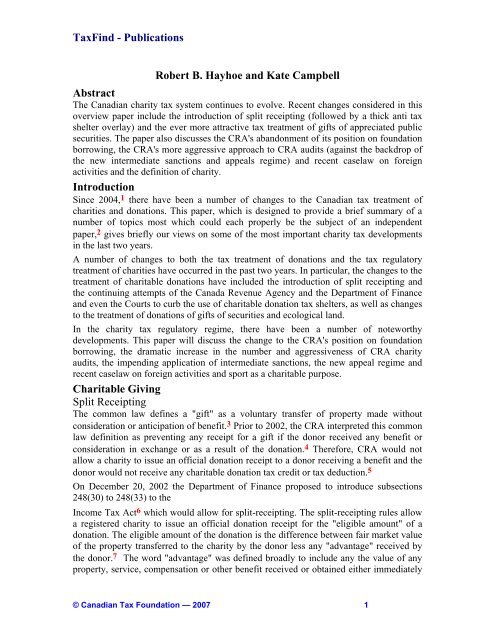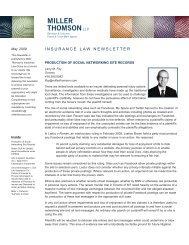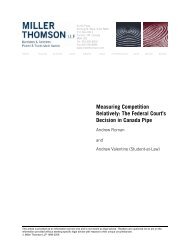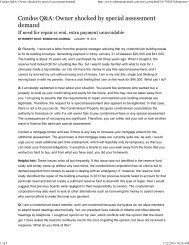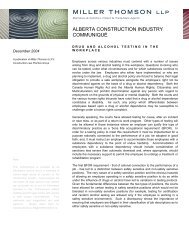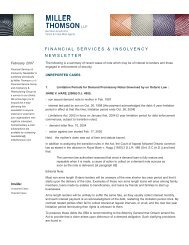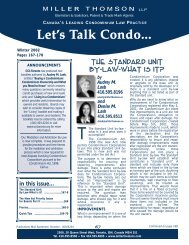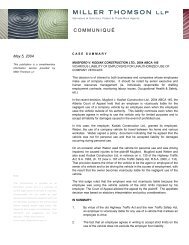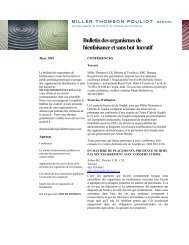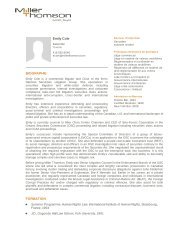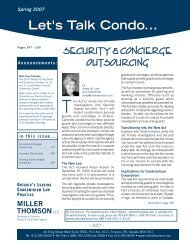TaxFind - Publications Robert B. Hayhoe and Kate ... - Miller Thomson
TaxFind - Publications Robert B. Hayhoe and Kate ... - Miller Thomson
TaxFind - Publications Robert B. Hayhoe and Kate ... - Miller Thomson
- No tags were found...
Create successful ePaper yourself
Turn your PDF publications into a flip-book with our unique Google optimized e-Paper software.
<strong>TaxFind</strong> - <strong>Publications</strong><strong>Robert</strong> B. <strong>Hayhoe</strong> <strong>and</strong> <strong>Kate</strong> Campbell<strong>Robert</strong> B. <strong>Hayhoe</strong> <strong>and</strong> <strong>Kate</strong> CampbellAbstractThe Canadian charity tax system continues to evolve. Recent changes considered in thisoverview paper include the introduction of split receipting (followed by a thick anti taxshelter overlay) <strong>and</strong> the ever more attractive tax treatment of gifts of appreciated publicsecurities. The paper also discusses the CRA's ab<strong>and</strong>onment of its position on foundationborrowing, the CRA's more aggressive approach to CRA audits (against the backdrop ofthe new intermediate sanctions <strong>and</strong> appeals regime) <strong>and</strong> recent caselaw on foreignactivities <strong>and</strong> the definition of charity.IntroductionSince 2004, 1 there have been a number of changes to the Canadian tax treatment ofcharities <strong>and</strong> donations. This paper, which is designed to provide a brief summary of anumber of topics most which could each properly be the subject of an independentpaper, 2 gives briefly our views on some of the most important charity tax developmentsin the last two years.A number of changes to both the tax treatment of donations <strong>and</strong> the tax regulatorytreatment of charities have occurred in the past two years. In particular, the changes to thetreatment of charitable donations have included the introduction of split receipting <strong>and</strong>the continuing attempts of the Canada Revenue Agency <strong>and</strong> the Department of Finance<strong>and</strong> even the Courts to curb the use of charitable donation tax shelters, as well as changesto the treatment of donations of gifts of securities <strong>and</strong> ecological l<strong>and</strong>.In the charity tax regulatory regime, there have been a number of noteworthydevelopments. This paper will discuss the change to the CRA's position on foundationborrowing, the dramatic increase in the number <strong>and</strong> aggressiveness of CRA charityaudits, the impending application of intermediate sanctions, the new appeal regime <strong>and</strong>recent caselaw on foreign activities <strong>and</strong> sport as a charitable purpose.Charitable GivingSplit ReceiptingThe common law defines a "gift" as a voluntary transfer of property made withoutconsideration or anticipation of benefit. 3 Prior to 2002, the CRA interpreted this commonlaw definition as preventing any receipt for a gift if the donor received any benefit orconsideration in exchange or as a result of the donation. 4 Therefore, CRA would notallow a charity to issue an official donation receipt to a donor receiving a benefit <strong>and</strong> thedonor would not receive any charitable donation tax credit or tax deduction. 5On December 20, 2002 the Department of Finance proposed to introduce subsections248(30) to 248(33) to theIncome Tax Act 6 which would allow for split-receipting. The split-receipting rules allowa registered charity to issue an official donation receipt for the "eligible amount" of adonation. The eligible amount of the donation is the difference between fair market valueof the property transferred to the charity by the donor less any "advantage" received bythe donor. 7 The word "advantage" was defined broadly to include any the value of anyproperty, service, compensation or other benefit received or obtained either immediately© Canadian Tax Foundation — 2007 1
<strong>TaxFind</strong> - <strong>Publications</strong>Initial Canadian government responses to charitable donation tax sheltersDefinition of giftThe initial response of the CRA to valuation-based shelters was to reassess to denydonation credit claims on the ground that the donations did not involve gifts at lawbecause they were motivated by tax benefit rather than philanthropy. The Federal Courtof Appeal disagreed with this approach in The Queen v. Friedberg. 11Flawed specific valuationsThe CRA was able to attack, with some success, many of the less sophisticated valuationshelters on the basis that the valuations were defective or had been prepared by thepromoters (for example, see The Queen v. Duguay 12 ). However, this approach was notalways available <strong>and</strong>, in any event, required a separate attack on each donation program.Amendment of personal use property definitionIn 2000, the Department of Finance made its first legislative attempt to end valuationbaseddonation programs. The attempt was made to do so through the introduction of theAct amendments which denied the $1,000 capital gains exemption for personal useproperty acquired from a promoter for the purpose of making a donation. 13 Thisamendment had very little impact on the market for valuation based programs, whichcontinued to grow. In fact, the only real impact of the change was that the "wholesale"prices at which goods were sold to prospective donors dropped by an amount largeenough to make the gifts cash-flow positive to donors even with the payment of tax onthe now taxable capital gain.Amendment of tax shelter definitionThe next legislative attack on valuation-based donation programs was an amendmentreleased in 2003 which changed the definition of "tax shelter" to include situations wheretax is saved by way of a tax credit as well as a deduction from income. 14 This changehad the effect of requiring valuation based donation programs to seek out a tax shelteridentification number which enabled the CRA to track donation based shelters <strong>and</strong> denyclaimed donation tax credits on a systematic basis. The change had little impact on thevolume of donations. 15Tax Court of Canada <strong>and</strong> Federal Court of Appeal require bulk valuationIn early 2004, the Tax Court of Canada decided Klotz v. the Queen, 16 which involved adonation of a large number of "fine art prints" as part of a valuation-based donationprogram. 17 The Court accepted the Crown's valuation approach that the market for art fordonations was so large that it formed its own market. This valuation theory was basedupon a series of U.S. Tax Court cases which had come to this conclusion in examiningsimilar programs which had been promoted to U.S. donors. The Court concluded that thistax shelter market is a bulk market <strong>and</strong> bulk pricing should be applied. While the Courtacknowledged the existence of a specific U.S. tax regulation (with no Canadiancounterpart) requiring that donation valuation be on the basis of the market in which theitem is "most commonly sold to the public," the decision placed little importance on thisdistinction.The Court in Klotz decided that the best evidence of the value of the prints in the taxshelter market was the amount paid by the donor. The result of this finding was that Mr.Klotz's donation ended up costing him the difference between the amount paid for the© Canadian Tax Foundation — 2007 3
<strong>TaxFind</strong> - <strong>Publications</strong>donated prints <strong>and</strong> the tax saving of about 45% of that amount. Subsequently, in 2005,the Federal Court of Appeal 18 affirmed that bulk valuation is appropriate where theproperty in question is traded in a bulk market.In Canada (A.G.) v. Nash, 19 taxpayers purchased limited edition prints from a tax shelterpromoter who sold groups of these prints to individuals, arranged for appraisals, thenlocated qualified donees willing to accept gifts of the prints. The taxpayers claimeddonation credits based on these arranged appraisals, which valued the art atapproximately three times what the taxpayers paid. However, on reassessment, theMinister reduced the fair market value of the donated artwork to the price actually paidthe taxpayers.The taxpayers appealed <strong>and</strong> won at the Tax Court of Canada, 20 but ultimately the FederalCourt of Appeal restored the Minister's assessment. Rothstein J.A. held that it wasinappropriate to assume that the fair market value of the group of prints was simply theaggregate of the fair market value of the individual prints. Here, the evidence revealedthat the promoter only sold groups of prints <strong>and</strong> that a well-defined bulk market existedwithin which these prints were sold year after year. Given that the promoter dealt with thetaxpayers at arm's length, Rothstein J.A. concluded that the fair market value of the printscould not have been the aggregate individual value of the prints, as an arm's lengthpromoter would have sold the prints at that price, rather than the lower price for whichthe prints were actually sold. As in Klotz, Rothstein J.A. held that the price paid by thetaxpayers was perhaps the "most probative evidence" of fair market value.Both the Klotz <strong>and</strong> Nash decisions indicate that courts in Canada have begun lookingwith increasing scrutiny at the valuation of bulk donations, particularly when made in thecontext of charitable donation tax shelters. These decisions suggest that many valuationbaseddonation programs may not have been effective even absent the various statutoryamendments designed to curtail <strong>and</strong> prevent their use. 21 Leave to appeal to the SupremeCourt of Canada was refused in each case. 22Anti-avoidance in the draft legislation 23The new provisions that have been piggy backed onto the draft legislation on splitreceipting impose the broadest <strong>and</strong>, from the government's st<strong>and</strong>point, most promisinganti-avoidance measures. Nonetheless, while these provisions were intended to eliminatecharitable donation tax shelters, various shelters remain available.Subsection 248(35) — attack on valuation-based sheltersProposed subsection 248(35) contains a broad anti-avoidance provision aimed atvaluation-based shelters. The section provides that where a donor's cost of propertydonated is less than the fair market value of the goods donated, no tax relief may beclaimed in respect of the excess amount if the property was acquired under a giftingarrangement with a tax shelter as defined in subsection 237.1(1). 24 Even where thedonated property was not acquired through a tax shelter program, a deduction or credit inrespect of the excess amount may only be claimed under certain circumstances. First, thedonor must have acquired the property more than three years prior to its donation. 25Second, where the property was acquired less than 10 years prior to donation, it must notbe reasonable to conclude than one of the main purposes of the acquisition of propertywas its eventual donation to a qualified donee. 26© Canadian Tax Foundation — 2007 4
<strong>TaxFind</strong> - <strong>Publications</strong>Proposed subsections 248(36) <strong>and</strong> (39) operate in conjunction with subsection 248(35) toensure that the basic rule in 248(35) is not avoided by filtering the gift through non-arm'slength transactions or by selling property to a charity <strong>and</strong> then donating the proceeds.Proposed subsection 248(38) provides a blanket rule that deems the eligible amount of agift to be nil if it is reasonable to conclude that the gift relates to a transaction or series oftransactions one of the purposes of which was to avoid the application of subsection248(35).Section 248(37) provides a list of excepted gifts to which subsection 248(35) does notapply. Subsection 248(35) does not apply to gifts of inventory, real property in Canada,cultural property, ecological property, <strong>and</strong> certain securities. Subsection 248(35) alsodoes not apply to gifts made in the year of death. 27Proposed subsection 248(41) imposes reporting requirements designed to render moretransparent dealings that might arouse suspicion. Subsection 248(41) requires that thedonor inform the donee of any circumstances surrounding the transaction to which any ofthe anti-avoidance provisions might apply; if the donor fails to do this, the eligibleamount of the gift is deemed to be nil (as apposed to the eligible amount properlycalculated).At one point charities were proposed to be subject to a parallel due diligence requirement.Formerly proposed subsection 248(40) provided that a charity could not issue a receiptfor donations in excess of $5000 unless the charity had made a reasonable inquiry as tothe existence of any circumstances in respect of which the anti-avoidance provisions insubsections (31)-(39) might apply. This included making reasonable inquiries intowhether an advantage had accrued to the donor that must be subtracted from the eligibleamount of the gift to arrive at an eligible amount under subsection 248(31). However, inlate 2005, the Department of Finance ab<strong>and</strong>oned this proposed requirement. 28Subsection 248(34) — attack on leveraged donation sheltersLeveraged donation shelters are newer <strong>and</strong> have received less attention from the courts.However, proposed subsection 248(34) attempts to close these shelters by reducing thegift by the borrowed amount. Subsection 248(34) provides that, effective February 18,2003, the amount of a donation is reduced by any amount borrowed to make the gift if theborrowing is limited recourse (defined broadly). An amount owing is deemed 29 to belimited recourse unless there are bona fide written arrangements to repay the debt within10 years <strong>and</strong> interest is paid annually within 60 days of the donor's year end <strong>and</strong> at leastat the CRA's prescribed rate.While the Department of Finance may have intended that loans which were used in earlyleveraged donation programs be caught by the definition of limited recourse, some newershelters appear to be designed to allow donors to borrow on a full recourse basis <strong>and</strong>thereby escape this anti-avoidance rule. These newer shelters involved donors makingreal borrowing in excess of the amount to be donated <strong>and</strong> investing the difference in highreturn investments. Since donors are subject to real economic risk <strong>and</strong> suffer realeconomic deprivation by making their gifts, <strong>and</strong> because therecipient charities appear to receive real benefit from the donations, it may be that someof these shelters will not be challenged or will survive if challenged.While the split-receipting/tax shelter anti-avoidance legislation is currently not enacted,© Canadian Tax Foundation — 2007 5
<strong>TaxFind</strong> - <strong>Publications</strong>its various components are retroactive to points as far back as December 20, 2002 <strong>and</strong>CRA is starting to administer these rules as if the legislation was enacted. In a recentadvance income tax ruling, 30 the CRA allowed for the split receipting of the donation.The donation was a piece of art to a museum on the condition that the art be loaned backto the donor for the duration of the donor's life. The CRA took the position that theadvantage flowing from the loan of the art back to the donor did not invalidate the gift.The ruling assumed that the work qualified as cultural property within the meaningcontained in subsection 118.1(1) <strong>and</strong> that proposed subsection 248(35) would not applyto deem the fair market value of the gift to be the individuals cost of the property.Similarly, the CRA has confirmed its intent to apply the new anti-avoidance rules to pasttax shelter transactions. 31Gifts of SecuritiesThe best news for the charitable sector last year was the Federal 2006 budgetannouncement that donors will not have to pay tax on the capital gain realized whenpublicly listed securities are gifted to a qualified donee, other than a private foundation. 32This capital gains exemption only applies to shares, debt obligations <strong>and</strong> rights listed on aprescribed stock exchange, shares of the capital stock of the mutual fund corporation, aunit of mutual fund trust, an interest in a related segregated fund trust, or a prescribeddebt obligation. 33 The prescribed stock exchanges in Canada include the Montréal StockExchange, the Toronto Stock Exchange, <strong>and</strong> Tiers 1 <strong>and</strong> 2 of the TSX VentureExchange 34 but not foreign or domestic over-the—counter markets. Donors of securitieslisted on a foreign exchange should check regulation 3201 of the Act to ensure the capitalgains exemption will apply.This change became law on June 22, 2006 <strong>and</strong> applies to gifts made after May 2, 2006.The provinces supported this change with both Ontario <strong>and</strong> Quebec (the only provinceswith independent personal income tax systems) announcing that they would harmonizethe provincial statutes to eliminate the capital gain on such gifts. 35Prior to the announcement, the taxable capital gain on gifts of publicly listed securitieswas ¬ of the capital gain. Thus, gifts of publicly listed securities were already taxed athalf of the rate of normal capital gains. The following table indicates the tax benefitsCash 997 — May 1, 2006(25% inclusion rate oncapital gains)May 2, 2006(0% inclusion rate on capitalgains)Amount of donation $100 $100 $100Tax credit 1Federal $29 $29 $29Provincial $17 $17 $17Reduction in capital gains tax 2 — $7 $14Total tax assistance 46% 53% 60%Donor's share of the cost of thedonation 54% 47% 40%1 Assumes that donor has made other donations totalling $200 or more in the year, so that the top tax credit rate applies.2 Reduction from the st<strong>and</strong>ard 50% inclusion rate that would apply if the individual sold the security. Assumes that the adjustedcost base of the security is $40.© Canadian Tax Foundation — 2007 6
<strong>TaxFind</strong> - <strong>Publications</strong>When the capital gains inclusion rate was reduced in 1997 to 25% donations of publicsecurities grew from approximately $69 million in 1997 to over $200 million in 2004. 37The 2006 Federal Budget estimated that the complete elimination of the capital gains taxon public securities donations would cause such gifts to increase to about $300 million ayear. 38The impact of these measures on the charitable sector was seen almost immediately. InMay, two very large donations were publicized. Larry <strong>and</strong> Judy Tanenbaum gifted $50million in securities to the endowment arm of the UJA Federation of Greater Toronto. 39Peter Munk donated $37 million to the Toronto General Hospital. 40 In October, Joseph<strong>and</strong> Wolf Lebovic made a $50 million gift to Mount Sinai Hospital. 41While this tax relief does not yet extend to such donations made to private foundations,the Conservative government stated it intends to enact similar relief for gifts to privatefoundations provided a suitable regime can be developed to prevent inappropriate selfdealingtransactions involving individuals who control public corporations <strong>and</strong> whoexercise control over the private foundations to which the shares are donated. 42 InDecember 2006, the St<strong>and</strong>ing Committee on Finance recommended a five-year trial basiselimination of capital gains tax on donations of publicly listed securities to privatefoundations. 43 The committee also recommended eliminating of capital gains tax ondonations of real estate to charities.Investment Asset RolloverThe charitable sector has raised concerns that the Conservative election promise to treatsales of investment assets on a rollover basis if the proceeds were reinvested in otherinvestment assets. 44 If implemented, this rollover may reduce the incentive to giftpublicly listed securities. Whether this promise will become law remains to be seen,though at least one report indicates that the Federal Government plans to move aheadwith it in due course. 45A Note about Flow-Through SharesAs a way to encourage exploration in the resource sector, the Federal Government usedflow-through shares, which allowed companies to pass along exploration deductions toinvestors. 46 Given that resource-sector companies are generally not profitable during theexploration stage, the company has little room to use the exploration losses. Flowthroughshares allow investors to use the costs of exploration to off-set gains elsewhere,while enjoying the possibility of receiving a capital gain in the shares.The introduction in May, 2006 of an exemption from capital gains tax for donations ofpublicly-listed securities to registered charities means that donations of flow-throughshares have the potential to cost investors very little. For example:An investor purchases $10,000 in flow-through shares of a publicly-listed issuer.The issuer agrees to renounce to the investor the deductible exploration expensesincurred. essentially this reduces the cost base of the shares to zero as the investorreceives $10,000 worth of deductions which equates to savings of approximately$4,600 (assuming a combined marginal tax rate of 46%). Thus, the net cost of theinvestment after deduction of these costs is $5,400 ($10,000-$4,600). 47Once the resource development is complete <strong>and</strong> the shares become marketable, then theinvestor can donate the flow-through shares to a registered charity <strong>and</strong> pay no tax on the© Canadian Tax Foundation — 2007 7
<strong>TaxFind</strong> - <strong>Publications</strong>gain of $10,000 (assuming the shares are still worth $10,000 - a big assumption). Theadjusted cost base of the shares is now zero. The investor receives a tax receipt for$10,000 which will shelter other income from tax. Assuming the investor is entitled todonation tax credit based on the current value of $10,000, which provides a tax savings of$4,600, it leaves the investor with an actual cost of only $800 ($5,400 - $4,600)." 48There are, however, reasons for charities to be cautious about accepting flow-throughshares. For example, the shares might be subject to hold periods or have otherrestrictions. Such attributes affect the marketability of shares <strong>and</strong> may suggest that fairmarket value for receipting purposes is not the original cost, or even the current tradingprice. For receipting purposes, fair value of the flow-through share security must bedetermined with care. 49Gifts of Ecologically Sensitive L<strong>and</strong>Since 1995, the Canadian Ecological Gift Program has allowed Canadians withecologically sensitive l<strong>and</strong> to protect nature <strong>and</strong> leave a legacy by donating the propertyor property rights, including an easement, covenant or Quebec servitude, to an eligiblecharity or the government. The 2006 Federal Budget made this program more attractiveby eliminating the capital gains tax on any gain realized on a donation made under thisprogram made after May 2, 2006. 50 Individual <strong>and</strong> corporate donors can still claim a taxcredit or deduction, respectively, for the value of the gift up to 100% of their net income<strong>and</strong> carry forward remaining credit or deduction for 5 years. 51 The ProvincialGovernments of Ontario <strong>and</strong> Quebec have announced that they would harmonize theirsystems regarding ecological gifts. 52Prior to this announcement capital gains on such donations were included at half of thenormal capital gains rate. Thus, only 25% of the gift was subject to capital gains tax whenproperty was gifted to a charity, opposed to 50% if the individual sold the property itself.Now the same gift will result in no capital gains tax.Ecologically sensitive l<strong>and</strong> is property that currently, or could at some point in the futurecontribute significantly to the conservation of Canada's biodiversity <strong>and</strong> environmentalheritage. 53 Since the program's inception in 1995 over $141 million worth of ecologicallysensitive property has been donated protecting 45,100 hectares of l<strong>and</strong>. 54In order to receive the tax benefits under this program, the Minister of the Environmentmust certify the property as ecologically sensitive l<strong>and</strong> <strong>and</strong> certify the fair market valueof the l<strong>and</strong>. 55 In order to certify the l<strong>and</strong> the Minister of the Environment requires donorsto submit a report on the ecologically sensitive nature of the gift <strong>and</strong> an appraisal reporton the fair market value of the l<strong>and</strong>. After reviewing the report the Minister will issue aNotice of Determination of the fair market value of the gift, which unless disputed will bethe value of the tax credit or deduction to the donor.Currently, there are 172 charities eligible to receive the donations of ecologicallysensitive property. 56 A Charity can apply to Environment Canada to become an eligiblerecipient a charity if it is registered in Canada <strong>and</strong> has a primary purpose such as "theconservation <strong>and</strong> protection of Canada's environmental heritage." While EnvironmentCanada does not prevent a private foundation from applying to become an eligiblecharity, the capital gain on donations of ecologically sensitive property to a privatefoundation is currently still subject to capital gains tax at the normal rate. Along with© Canadian Tax Foundation — 2007 8
<strong>TaxFind</strong> - <strong>Publications</strong>gifts of publicly listed securities, discussed above, the government is consideringextending the elimination of capital gains tax on gifts to private foundations ofecologically sensitive l<strong>and</strong>. 57Recipients of gifts of ecologically sensitive l<strong>and</strong> are responsible for maintaining thebiodiversity <strong>and</strong> environmental heritage of the property in perpetuity. EnvironmentCanada expects a recipient charity to have a management plan regarding environmentalstewardship, monitoring, visitor safety, <strong>and</strong> remediating environmental hazards. Therecipient must also consider the costs of ongoing liability insurance <strong>and</strong> property taxes. Ifa charity or municipality disposes of the property or changes the use of the propertywithout the permission of the Minister of the Environment, the charity or municipalitymust pay a tax of 50% of the fair market value of the l<strong>and</strong>. 58Case LawBenquesusOne interesting recent donation case was the decision of the Tax Court of Canada inBenquesus v. Canada. 59 In the case, the transaction at issue was the transfer of funds byMr. Benquesus, a non-resident father of four adult Canadian resident children. Hetransferred funds to a Canadian registered charitable organization, but did so on the basisof documents confirming that the funds transferred to the charity were loaned to thecharity — he then gifted the loan receivable to his children.The children partially forgave the loan in 1999, prompting the charity to issue thechildren charitable receipts for the amounts forgiven. The CRA reassessed the childrens'tax returns <strong>and</strong> disallowed the charitable donation tax credits claimed by them on thebasis that the funds were really gifted to the charity by Mr. Benquesus, the father.However, the Court determined that the father had gifted the funds to the children,leaving it for them to decide whether <strong>and</strong> how much money to donate to the charity. TheCourt looked at the common law definition of a gift, finding that the three requirementsof a valid gift were present. 60 There was an intention to donate, acceptance of the gift bythe donee <strong>and</strong> delivery of the gift to the donee. As a result, the funds were gifted by Mr.Benquesus to his children <strong>and</strong> it was ultimately up to the four children to determine howmuch to donate to the charitable organization. 61This case is an interesting contrast with R. v. Bromley. 62 In that case an individual loanedmoney to a charity then gave the loan receivable to his arm's length lawyer who forgavethe loan. The CRA, perhaps because of the absence of family ties in this situation, viewedthe matter very seriously <strong>and</strong> charged the lawyer with evasion. The accused was acquittedconclusively <strong>and</strong> the Court certainly did not conclude that the Crown's underlying taxliability theory was necessarily correct.Charity Tax Regulatory ChangesFoundation LoansPrior to 2005, the CRA took the position that a charitable foundation borrowing to investwas incurring a debt that a foundation was not otherwise permitted by the Act to incur.Subsection 149.1(3) (applicable to public foundations), <strong>and</strong> s. 149.1(4) (applicable toprivate foundations), give the Minister the power to revoke the charitable status of afoundation in a variety of circumstances, including where a foundation has incurredcertain types of debt. The relevant provision, which is worded identically in both s.149(3)© Canadian Tax Foundation — 2007 9
<strong>TaxFind</strong> - <strong>Publications</strong><strong>and</strong> (4) permits revocation of a charity that:incurred debts, other than debts for current operating expenses, debts incurred inconnection with the purchase <strong>and</strong> sale of investments <strong>and</strong> debts incurred in thecourse of administering charitable activities;While on the face of it, the exceptions seem so broad as to exclude all debts, includingones made for the purpose of permitting investments to be purchased the CRA for manyyears took the position that the reference to "debts in connection with the purchase <strong>and</strong>sale of investments only contemplated short-term amounts owing to a broker (forexample) after a purchase has been made, as opposed to longer-term debt associated withborrowing to buy investment assets. 63As a result of a challenge brought by way of judicial review by the Acorn Foundation, theFederal Court Trial Division suggested that it was prepared to reconsider thisinterpretation 64 <strong>and</strong> the CRA issued a technical interpretation 65 accepting thatfoundations may borrow to purchase investments. 66 This change is potentially quitebeneficial to donors in some situations. For example it allows a high net worth/lowincome donor to capitalize a private foundation now, delaying the use of the tax credituntil needed (perhaps as a result of death).CRA Audits 67Historically, CRA charity audits were rare <strong>and</strong> were usually resolved through complianceundertakings. 68 The CRA has taken a more rigorous approach to auditing charitiesfollowing the introduction of intermediate sanctions <strong>and</strong> the new objection <strong>and</strong> appealprocess. Audit activity in the sector increased <strong>and</strong> in 2006, the Canada Revenue AgencyCharities Directorate estimated that 1% of the registered charities in Canada would beaudited. 69The Charities Directorate stated that it hoped the increased audit activity would lead toenhanced compliance with the requirements of the Act by educating charities. TheCharities Directorate assured charities <strong>and</strong> charity tax professionals that the introductionof the intermediate sanctions would not change the educational approach to charityaudits. 70In the past, the severe consequences of revocation (until recently the only sanctionavailable to the CRA), including the loss of tax exempt status, loss of ability to issueofficial donation receipts <strong>and</strong> a revocation tax equal to full value of the charities assetsmade the CRA reluctant to apply the revocation sanction. 71 The published policy of theCRA <strong>and</strong> our experience until recently was that the CRA would only revoke if a charitywas found to be engaged in egregious behaviour akin to fraud or if the charity wasignoring the undertakings it made as a result of a previous audit. 72Over the last year, we have seen a disturbing trend of auditors proposing to revokeregistration for relatively trivial non-compliance issues that would have been the subjectof an education letter of undertakings in the past according to Guide T4118. Revocationappears to be pushed by CRA for first time offences, despite the willingness of thecharities to undertake or agree to comply in the future. We had expected an auditcrackdown as a result of the introduction of intermediate sanctions - this has occurred butseems to have started with revocations for audit years preceding the application ofintermediate sanctions.© Canadian Tax Foundation — 2007 10
<strong>TaxFind</strong> - <strong>Publications</strong>Perhaps this is due in part to the movement of the audit program from the direct controlof the Charities Directorate to the local CRA Tax Services Office tax auditors. Theseauditors seem to bring a tax compliance m<strong>and</strong>ate to bear on charities audits, since theyare proposing to revoke charities in situations that would not have resulted in revocationin the past. These auditors may not have as much background in the charity sector <strong>and</strong>seem to take the approach that the charities under audit have been chosen for a reason <strong>and</strong>are likely to be non-compliant.Intermediate SanctionsAs discussed above, traditionally revocation was the only sanction that could be imposedon a charity <strong>and</strong> it had drastic consequences. The 2004 Federal Budget changed this withthe introduction of the intermediate sanctions. 73 Intermediate sanctions are designed asalternatives to the revocation of charitable status for minor or unintended infractions. Thetable below sets out the intermediate sanctions.Section Infraction Penalty Penalty for Repeat with 5years of first assessedpenalty188.1(1), (2),188.2(1)188.1(3),149.1(12)188.1(4), (5),188.2(1)Private foundation carrying onany business or other charitycarrying on an unrelatedbusinessFoundation acquires control ofa corporationUndue personal benefitprovided by a charity to anyperson188.1(6) Failure to file or late filing ofinformation return188.1(7), (8) Issuing receipts with incorrectinformation188.1(9), (10),188.2(1)5% of gross revenue from thebusiness5% of the dividends receivedfrom the corporation105% of the amount of thebenefit$5005% of the amount on thereceipt for which a credit ordeduction may be claimedKnowingly making a false 125% of the amount on thestatement or causing another to receipt for which a credit ormake a false statement on a deduction may be claimed (orreceiptthe penalty under 163.2 ifgreater); if penalty exceeds$25,000 then suspension ofauthority to issue officialreceipts for one year188.1(11) Delay expenditure of amountsof charitable activities throughthe transfer of fund to anotherregistered charity188.2(2) Contravention of verification<strong>and</strong> enforcement provisionsincluding books <strong>and</strong> records,audits <strong>and</strong> requirements toprovide information;188.2(2) Receipting on behalf of asuspended charityEach charity is jointly <strong>and</strong>severally liable to a penalty of100% of the fair market valueof the property transferredSuspension of authority toissue receipts for one yearSuspension of authority toissue receipts for one year100% of gross revenue fromthe business; suspension ofauthority to issue officialreceipts for one year100% of dividends receivedfrom the corporation110% of the amount of thebenefit; suspension of authorityto issue official receipts for oneyear10% of the amount on thereceipt for which a credit ordeduction may be claimed© Canadian Tax Foundation — 2007 11
<strong>TaxFind</strong> - <strong>Publications</strong>Penalties in excess of $1000 in a year can be paid to an "eligible donee" instead of thegovernment. 74 Penalties can also be reduced by expenditures on the charity's owncharitable activities in excess of its income for the year. 75The sections apply in respect of taxation years that begin after March 22, 2004. Thus, forcharities with a December 31st year end will apply in 2005. While the CRA has just nowstarted to audit years in which these sanction may apply, we are not aware of anyintermediate sanction assessments having been issued — thus it is unclear how CRA willapply the rules <strong>and</strong> how the courts will interpret them. 76 Hopefully these rules will beapplied sensibly considering other attempts to educate the charity <strong>and</strong> the severity of thebreach, rather than penalizing charities for inadvertent <strong>and</strong> technical contraventions. Alsoit is hoped that these rules will be applied before CRA resorts to revocation, rather thanapplying the intermediate sanctions together revocation.The New Appeal Process: Implemented, but not yet PopulatedA new appeals process has been implemented which is applicable to all CRA charitycompliance decisions, in respect of notices issued by the Minister of National Revenueafter June 12, 2005. 77 Prior to the 2004 Federal Budget, a charity could only appeal CRAdecisions regarding the failure to register the charity <strong>and</strong> decisions to revoke theregistration of a charity. These appeals were taken to the Federal Court of Appeal whichwas costly <strong>and</strong> charities could not add further evidence.This prior appeal system often forced charities to acquiesce to CRA dem<strong>and</strong>s, such as anundertaking letter. Since the undertaking letter was based on an administrative practiceset out in CRA Guide T-4118, "Auditing Charities", the ordinary appeal mechanism ofjudicial review by the Federal Court of Appeal was not available to a charity facing achoice between revocation <strong>and</strong> signing an undertaking. 78 While a charity could allow theCRA to revoke the charity's registration <strong>and</strong> then bring a judicial review appeal to theFederal Court of Appeal this was a costly <strong>and</strong> risky choice. Therefore, charities usuallyacquiesced to the CRA dem<strong>and</strong>s, even if the charity <strong>and</strong> its advisors believed on areasonable basis that the undertakings were unnecessary (on the other h<strong>and</strong>, it is nowclear because one charity refused to so acquiesce that a charity facing an unreasonableundertaking dem<strong>and</strong> is able to bring a judicial review application in the Federal Court ofAppeal). 79Under the new appeal process charities can object to a wide range of decisions under165(1) of the Act. 80 Charities objecting to a penalty, revocation, revocation tax,annulment, decision not to register the charity or a suspension of the charities ability toissue official receipts must first serve the Minister a notice of objection on or before theday that is 90 days after the day the assessment is mailed. 81 The Notice must identify thedecision objected to <strong>and</strong> relevant facts. The Appeals Branch of CRA will review thedecision. The Appeals Branch has the power to uphold, vary, or disagree with the originalCRA decision.If the charity wants to appeal the decision of the Appeals Branch the process depends onthe matter involved. Decisions on the registration, charitable designation, revocation <strong>and</strong>annulment will still be appealed to the Federal Court of Appeal. 82 Other appealsincluding the amount of revocation tax assessed, a suspension of the charities ability to© Canadian Tax Foundation — 2007 12
<strong>TaxFind</strong> - <strong>Publications</strong>issue official receipts <strong>and</strong> intermediate sanctions can be appealed to the Tax Court ofCanada. 83 A charity can also apply to have the Tax Court of Canada postpone thesuspension of its receipting privileges even before an appeal is launched. 84New rules have not yet been promulgated in the Tax Court to deal with intermediatesanction appeals, however we assume such appeals will function like ordinary taxappeals. 85 Thus, the charity should be able to present new evidence <strong>and</strong> avail itself of theinformal procedure.Currently these procedures not been populated with cases, although the internal appealsprocess is beginning to see files (we have a couple of revocation matters at Appeals, butnone have yet been resolved). Hopefully the new process will be more accessible <strong>and</strong>responsive to the needs of charities. We shall see as these matters come before the courtsin the next few years.It will be interesting to see how Appeals conceives its m<strong>and</strong>ate in h<strong>and</strong>ling charityappeals. It is not clear whether the Appeals review should be aimed at the correctness(can the decision be defended?) of the CRA's decision or at the advisability of thedecision (was the decision the right one in the circumstances?) given that the impositionof both revocation <strong>and</strong> intermediate sanctions is discretionary. It is also not clear whetherthe introduction of CRA Appeals involvement reduces or eliminates the duty of fairnessimposed on the CRA Charities Directorate in revocations matters by Re: RenaissanceInternational 86 - we suggest not.Case LawBayit Lepletot 87The Federal Court of Appeal judgment in Bayit Lepletot denied a charity's appeal of itsrevocation of charitable status. 88 At issue was whether the charity carried on its owncharitable activities overseas. The Act requires that a Canadian registered charity devoteits resources to its own charitable activities or make to grants to qualified donees.Bayit Lepletot ("Bayit Canada") was a Canadian registered charity established to supportan Israeli organization with the same name ("Bayit Israel"). Bayit Canada had appointedRabbi Stern, an Israeli resident, as its agent to carry out charitable activities in Israel.Rabbi Stern was the "Directorate in Residence" of the three charitable institutions fororphans operated by Bayit Israel.The Court confirmed that a charity can carry on its own activities overseas through anagent because under the common law the activities of an agent are deemed to be activitiesof its principal. 89 However the court stated that it must be shown that the agent is actuallycarrying on the charitable works. In this case the court held that the charitable works werethose of Bayit Israel, not Rabbi Stern. Therefore, since Bayit Canada had an agencyagreement with the wrong party in Israel it was not carrying on its own charitableactivities.The court also dismissed on the facts the alternative argument that Rabbi Stern had a subdelegatedhis agency functions to Bayit Israel. While the Court accepted the potentialapplication of the subagent doctrine, it concluded that this case lacked the factual basisfor concluding that such a subagency arrangement had been implemented.Therefore, the Bayit case, judgment st<strong>and</strong>s for two propositions:© Canadian Tax Foundation — 2007 13
<strong>TaxFind</strong> - <strong>Publications</strong>• while a Canadian charity may carry out its own charitable activities through anagent, it is important to ensure that the agent appointed is actually the legal personthat carries out the activities on the ground, <strong>and</strong>• it may be possible for an agent appointed by a Canadian registered charity to subdelegatedthe charitable work of the Canadian organization to a subagent providedthere is factual proof of the sub-delegation.A.Y.S.A.In A.Y.S.A. Amateur Youth Soccer Association v. Canada Revenue Agency, 90 the FederalCourt of Appeal held that an organization whose purpose was the promotion of amateursoccer could not be registered as a charity.The Amateur Youth Soccer Association ("AYSA") was established to promote the sportof soccer in Ontario, especially amateur youth soccer. The Federal Court of Appeal notedthat the main objective of AYSA was to offer youths the opportunity to develop pride intheir abilities <strong>and</strong> soccer skills. It was common ground that AYSA's purpose <strong>and</strong> objectwas the promotion of soccer as an end in itself <strong>and</strong> that this purpose was not incidental toany other purpose.CRA refused to register the charity stating that the promotion of sport in itself is not acharitable activity. In its refusal letter CRA took the view that while the promotion ofhealth (a recognized charitable purpose) may include activities aimed at increasing thephysical fitness of youth through sporting activities, AYSA was focused on thepromotion of soccer, not the promotion of health through physical fitness.As the term charity is not defined in the Act, courts must rely on common law definitionof charity. AYSA argued that the Ontario case of Re Laidlaw Foundation, 91 supportedthe proposition that under Ontario law the promotion of athletic sport is, by itself, acharitable purpose. AYSA conceded that the overwhelming weight of the common lawauthorities was consistent with the view that the promotion of sport per se is notcharitable, but it argued that the Ontario common law <strong>and</strong> Laidlaw applied.The Federal Court of Appeal noted that the courts have consistently held throughout thecommon law world that the pursuit of sports was not charitable, unless it was incidentalto some other purpose. However rather than decide if sport in itself was charitable, theFederal Court of Appeal held it did not need to decide the issue because the Act alreadyprovided for the tax status of sports organizations in a manner which precludes thepossibility of AYSA being registered a charitable organization. According to the FederalCourt of Appeal the specific tax exemption for Canadian amateur athletic associationsprecludes the possibility that AYSA could qualify as the charity. Registered CanadianAmateur Athletic Associations (RCAAA) that promote sports on a national basis canissue tax receipts under the Act. 92 The Court held that "Parliament must be taken to havebeen aware that no association which has, as its main purpose, the pursuit of amateursport could qualify as a charity under the common law, <strong>and</strong> hence, under the Act... In myview, this scheme precludes the possibility that an amateur sport association be treated asa charity under the Act." 93This broad statement caused concern that a sports organization can never be a charitable<strong>and</strong> it contradicts the earlier recognition that sport is charitable when incidental to anothercharitable purpose. These statements can only be reconciled if the Court's statements arelimited to sport organizations that are not charitable under the existing common law.© Canadian Tax Foundation — 2007 14
<strong>TaxFind</strong> - <strong>Publications</strong>Under this interpretation the decision supports the proposition that the introduction ofRCAAAs meant that Parliament did not intend to make organizations organized solelyfor the purpose of the promotion of sport in itself charitable, but rather it granted charitylikebenefits to such organizations operating nationally.The Appellant has been granted leave to appeal to the Supreme Court of Canada.Hopefully, the Supreme Court will narrow the unnecessarily broad statements made bythe Federal Court of Appeal. The Supreme Court of Canada will also have theopportunity to clarify the proper interaction between charities <strong>and</strong> RCAAAs, as well as,opine on whether the promotion of sport itself is charitable.ConclusionThe case law <strong>and</strong> policy changes that have occurred over the last several years reveal thatcharities law has changed in a number of ways. Some developments, like the introductionof a new appeals process <strong>and</strong> intermediate sanctions, are likely to have a relatively largeimpact on the not only the way that charities conduct their activities, but also how theCRA monitors the sector. To some extent, these changes have already brought about amodification of CRA monitoring mechanisms, as the increase in CRA audits shows.Other changes, however, provide more in the way of clarification than outright change.The case law reveals that litigation is causing a slow evolution of charities law. At thesame time, some of the recent developments coming from the CRA, like its explanationof the public benefit test, also reveal a gradual approach to changes in the rules governingcharities. Nevertheless, these less radical alterations to the law affecting charities areequally as important as the more dramatic shifts that have happened in recent years. Asthe charitable sector continues to increase in importance, staying current on theinformation <strong>and</strong> changes affecting the industry is important to all stakeholders, fromdonors <strong>and</strong> charities to their tax advisors.DRAFT FOOTNOTES1 When the Canadian Tax Foundation Annual Conference last included a set of charity tax papers: SusanM. Manwaring <strong>and</strong> <strong>Robert</strong> B. <strong>Hayhoe</strong>, "Charities Update: 2004 Budget Proposals," Report ofProceedings of Fifty-Sixth Tax Conference, 2004 Tax Conference (Toronto: Canadian Tax Foundation,2005), 8:1-28; <strong>and</strong> Patrick J. Boyle, "Charitable Gifts: An Update," Report of Proceedings of Fifty-Sixth Tax Conference, 2004 Tax Conference (Toronto: Canadian Tax Foundation, 2005), 7:1-36("Boyle CTF").2 Indeed, as we will show through our citations, a number of these more detailed papers have alreadybeen written by us or others.3 See Friedberg v. The Queen, (1991), 92 D.T.C. 6031; [1992] 1 C.T.C. 1 (F.C.A.), aff'd [1993] 4 S.C.R.285 <strong>and</strong> Woolner v. Canada(Attorney General) (1999), [2000] 1 C.T.C. 35; (1999), 53 D.T.C. 5722 (F.C.A.).4 For more detail on the traditional definition of gift, see David P. Stevens, "Update on CharityTaxation", in Report of the Proceedings of the Fifty-Third Tax Conference, 2001 Conference Report(Toronto: Canadian Tax Foundation, 2001) 28:1-56.5 That said, as discussed in Boyle CTF, supra note 1, the case law did sometimes permit partialreceipting: Aspinall v. M.N.R., (1970), 70 DTC 1669 (TAB), The Queen v. Z<strong>and</strong>stra, (1974), 74 DTC6416; [1974] CTC 503 (FCTD), The Queen v. McBurney, (1985), 85 DTC 5433; [1985] 2 CTC 214(FCA) <strong>and</strong> Woolner, supra note 3. On one theory, this was a recognition that the Quebec civil lawcontained a different definition of gift: Blake Bromley, "Flaunting <strong>and</strong> Flouting the law of gift:Canada Customs <strong>and</strong> Revenue Agency's Philanthropobia" (2002), 21 Est. <strong>and</strong> Tr. J. 177-208.6 Income Tax Act, RSC 1985, c. 1 (5th Supp.), as amended (herein referred to as "the Act"). Statutory© Canadian Tax Foundation — 2007 15
<strong>TaxFind</strong> - <strong>Publications</strong>references in this paper are references to the Act unless otherwise indicated.7 Proposed Subsection 248(31).8 Explanatory Notes to Section 248(32).9 Income Tax Technical News No. 26, December 24, 2002.10 For a more detailed description of charitable donation (<strong>and</strong> other) tax shelters in Canada, see GrahamTurner, "Tax Shelters — Past, Present <strong>and</strong> Future," (2003) 1654 CCH Tax Topics 1 or Gabrielle St.Hilaire, "Buying Law, Donating High: Arrangements, Programs, Schemes <strong>and</strong> Scams" (2006) vol. 16,no. 10 Canadian Current Tax 101-106. The first draft of a portion of this section of this paper wasbased on R. <strong>Hayhoe</strong>, "The End of Charitable Donation Tax Shelters in Canada?" (2004), 44:1 ExemptOrganization Tax Review 69.11 (1991), 92 DTC 6031; [1992] 1 CTC 1 (FCA) (upheld by the Supreme Court of Canada on othergrounds, (1993), 93 DTC 5507; [1993] 2 CTC 306). However, see McPherson v. Canada [2006] T.C.JNo. 519 where the Court concluded that a donation resulting in a cash "Kickback" of 75% of thedonated amount was not a gift.12 2000 DTC 6620; [2002] 1 CTC 8 (FCA)13 Subsection 46(5).14 Section 237.1.15 Indeed, Graham Turner, supra note at 4, suggests that the change actually resulted in an increase involume!16 2004 TCC 147; [2004] 2 CTC 2892.17 Interestingly, the Klotz donations were to the University of Florida, which is a qualified donee forCanadian tax purposes. It appears that some promoters of these programs arranged specifically that theprints would be donated to non-Canadian qualified donees, perhaps on the theory that the Act gives theCanada Revenue Agency no practical ability to oversee their issuance of charitable donation receipts.18 2005 DTC 5279 (FCA)19 2005 DTC 5696; [2006] 1 CTC 158 (FCA).20 2004 DTC 3391 (TCC).21 Although, since valuation is a matter of fact (as acknowledged by Revenue Canada in the gift contextin Revenue Canada document no. 9800605, January 26, 1998), this conclusion may not always be true.22 Nash v. Canada, [2006] S.C.C.A No. 20, [2006] S.C.C.A. No. 21, [2006] S.C.C.A. No. 22; Klotz v.Canada [2005] S.C.C.A. No 286.23 There has been extensive commentary on these proposed anti-avoidance rules. See Rob DePetris,"Stopping Perceived Abusive Charitable Tax Schemes <strong>and</strong> Much More," in 2004 Ontario TaxConference, (Toronto: Canadian Tax Foundation, 2004), 5B:1-17; J. Maureen Pappin, CA, "December20, 2002 Draft Technical Changes - Charitable Donations, Charities <strong>and</strong> Trusts," in 2003 Ontario TaxConference, (Toronto: Canadian Tax Foundation, 2003), 5:1-32.24 Proposed Paragraph 248(35)(a).25 Proposed Subparagraph 248(35)(b)(i).26 Proposed Subparagraph 248(35)(b)(ii).27 Proposed Paragraph 248(35)(b).28 In response to vociferous objections on the part of charities <strong>and</strong> their advisors: <strong>Robert</strong> B. <strong>Hayhoe</strong>,"Federal Legislation Creates New Diligence Requirements for Charities" (2005), vol. 25, no. 16Lawyers Weekly 10 <strong>and</strong> <strong>Robert</strong> B. <strong>Hayhoe</strong>, "Finance Ab<strong>and</strong>ons Diligence Requirement for CharitiesReceiving Large Gifts" (2005),vol. 25 no. 30 Lawyers Weekly 8.29 By proposed subsection 143.2(6.1).30 CCH, "Gift of Work or Art Combined with Loan for Use", Window on Canadian Tax Commentary,2006, #8773. See also CRA document No. 2006 — 0170391R3, Advance Income Tax Ruling, August2, 2006.© Canadian Tax Foundation — 2007 16
<strong>TaxFind</strong> - <strong>Publications</strong>31 Canada Revenue Agency "Warning Tax Shelter Gifting Arrangements are Risky" Alert, October 31,2006.32 Canada, Department of Finance, 2006 Budget, Budget Plan, May 2, 2006.33 Subsection 38(a.1).34 Regulation 3200 <strong>and</strong> 3201.35 Ontario Ministry of Finance Information Bulletin, "Supporting Donations to Charities <strong>and</strong> Gifts ofEcologically Sensitive L<strong>and</strong>", August 2006, <strong>and</strong> Revenue Québec, Income Tax Return/Guide 2006,"393 Donations <strong>and</strong> Gifts", 51.36 Adapted from the 2006 Budget, 121.37 2006 Budget, 122. For discussion, about the policy rationale <strong>and</strong> ramifications of the incentive, seeAlex<strong>and</strong>re Laurin, "The Taxation of Capital Gains on Charitable Donations of Listed Securities",Library of Parliament, Parliamentary Research Branch, November 13, 2003.38 2006 Budget, 122.39 Campbell Clark, "Tanenbaum family donates $50-million", Globe <strong>and</strong> Mail (20 May, 2006)40 CBC News, "Munk donates $37 million to cardiac centre" (May 30, 2006)41 Dawn Walton "Brothers to give $50-million to Toronto hospital; Mount Sinai to benefit from largesteversingle donation", The Globe <strong>and</strong> Mail (27 October 2006) A3.42 2006 Budget, 123.43 Report of the St<strong>and</strong>ing Committee of Finance, "Canada: Competing to Win" December 2006.44 Conservative Party of Canada Federal Election Platform 2006, St<strong>and</strong> Up for Canada, 16. TheConservative Party pledged to "Eliminate the capital gains tax for individuals on the sale of assetswhen the proceeds are reinvested within six months. Canadians who invest, or inherit cottages offamily heirlooms, should be able to sell those assets <strong>and</strong> plough their profits back into the economywithout taking a tax hit."45 It appears that the Federal Government intends to pursue the asset rollover. See Jack M. Mintz, "ToryTax Relief: The Conservatives will deliver on their promise to give investors relief from capital gainstax", National Post, October 11, 2006.46 For more detail on the tax treatment of flow-through shares, see Vijay M. Jog, Gordon J. Lenjosek, <strong>and</strong>Kenneth J. McKenzie, "Flowthrough Shares: Premium-Sharing <strong>and</strong> Cost-Effectiveness," (1996), vol.44, no. 4 Canadian Tax Journal, 1016-1051.47 Bryant Frydberg <strong>and</strong> Susan Manwaring, "Charitable Donations <strong>and</strong> Flow-Through Shares", 20Charitable Thoughts No. 1.48 Ibid.49 Ibid.50 Proposed Section 38(a.2).51 Paragraphs 110.1(1)(d), 118.1(1)"total ecological gifts" <strong>and</strong> "total gifts", <strong>and</strong> 118.1(3).52 For an overview of the programs in Quebec see Environment Canada, "The Ecogifts Program inQuebec", online: Environment Canada <strong>and</strong>in Ontario see http://www.on.ec.gc.ca/wildlife/ecogifts/ecogifts-e.html53 We are not aware of l<strong>and</strong> outside of Canada ever qualifying, although we see no reason in principlewhy it could not: <strong>Robert</strong> B. <strong>Hayhoe</strong>, "A Critical Description of the Canadian Tax Treatment of Cross-Border Charitable Giving <strong>and</strong> Activities," (2001), vol. 49, no. 2 Canadian Tax Journal, 320-337 at 328.54 See the Canadian Ecological Gift Program website for more information at http://www.cwsscf.ec.gc.ca/egp-pde/55 Paragraphs 110.1(1)(d) <strong>and</strong> 118.1(1) "total ecological gifts".56 http://www.cws-scf.ec.gc.ca/egp-pde/57 Report of the St<strong>and</strong>ing Committee of Finance, "Canada: Competing to Win" December 2006.58 Section 207.31 of the Act.© Canadian Tax Foundation — 2007 17
<strong>TaxFind</strong> - <strong>Publications</strong>59 [2006] T.C.J. No. 149.60 Ibid at para. 4.61 Ibid at para. 13.62 R v. Bromley, [2004] B.C.J. No. 481.63 For example, see Technical Interpretation Letter 9700205, April 4, 1997 or Charities InformationLetter CIL-1998-030,October 16, 1998.64 Acorn Foundation v. M.N.R. (16 December 2005), Court File no. T-1784-05 (FCTD) [unreported].65 CRA Technical Interpretation Letter 2005-0154751I7, October 21, 2005.66 As discussed in R.B. <strong>Hayhoe</strong>, 'Federal Court Reviews CRA Undertaking Letter'(2006), 14:2 CanadianNot-for-Profit News 13.67 For a more practical look at charity audit response, see <strong>Robert</strong> <strong>Hayhoe</strong>, "Canada Customs <strong>and</strong> RevenueAgency Charities Audits" (2003) 17 The Philanthropist 38.68 Registered Charities Newsletter No. 27, Fall 2006.69 Ibid.70 Ibid.71 Canada Revenue Agency, "Registering Charities <strong>and</strong> the Income Tax Act", RC 4108(E) 1204.72 Canada Revenue Agency, "Auditing Charities — T4118", March 3, 2004.73 Canada, Department of Finance, 2004 Budget, Budget Plan, March 23, 2004.74 Subsections 189(6.2), <strong>and</strong> (6.3).75 Subsection 189(6.2).76 For a discussion about how the new Canadian sanctions should be applied with reference to Americancase law, see <strong>Robert</strong> B. <strong>Hayhoe</strong> <strong>and</strong> Marcus S. Owens, "The New Tax Sanctions for CanadianCharities: Learning from the US Experience," (2006), vol. 54, no. 1 Canadian Tax Journal, 57-86. Seealso Louis Tassé, "Policy Forum: The New Regime for Charities - Further Reflection," (2006), vol. 54,no. 1 Canadian Tax Journal, 211-220.77 Budget Implementation Act, 2004,No. 2, S.C. 2005.c.19, ss. 38, 45.78 Supra note 72.79 Acorn Foundation, supra note 64.80 Subsection 189(8) of the Act.81 Subsections 165(1) <strong>and</strong> 168(4) of the Act.82 Subsections 189(8.1), 168(4) <strong>and</strong> 172(3) of the Act.83 Subsections 189(8) <strong>and</strong> 169(1) of the Act.84 Subsection 188.1(4) of the Act.85 Tax Court of Canada rules (General Procedure), SOR/90-688, as amended.86 Re Renaissance International v. Minister of National Revenue (1982), 142, D.L.R. (3d) 539 (FCA).87 As discussed in Patrick J. Boyle et al., "Canada-U.S. Boundary Issues for Cross-Border CharitableActivities" Taxation of Exempts (November/December 2006) 129.88 Bayit Lepletot v. Canada (Minister of National Revenue), [2006] F.C.J. No. 505.89 G.H.L. Fridman, The Law of Agency, 7th Ed. (Toronto: Butterworths, 1996) at 216 <strong>and</strong> CameronHarvey, Agency Law Primer, 2nd Ed. (Toronto: Carswell, 1999) at 77.90 2006 FCA 136, leave to appeal granted [2006] S.C.C.A. No 206.91 (1984), 13 DLR (4th) 491 (Ont. Div. Ct.).92 Subsection 248(1) "Registered Canadian Amateur Athletic Association", 118.1(2), 110.1(2), <strong>and</strong>Regulation 3501.93 A.Y.S.A. at para. 20.AUTHOR INFORMATION© Canadian Tax Foundation — 2007 18
<strong>TaxFind</strong> - <strong>Publications</strong><strong>Robert</strong> <strong>Hayhoe</strong>. <strong>Miller</strong> <strong>Thomson</strong> LLP, Toronto. B.A. (1992) University of Toronto,LL.B. (1995) University of British Columbia, LL.M. (2000) Osgoode Hall Law School atYork University, T.E.P.. Co-author with Arthur Drache <strong>and</strong> David Stevens of CharitiesTaxation, Policy <strong>and</strong> Practice looseleaf service. Frequent writer <strong>and</strong> speaker on tax <strong>and</strong>charity subjects.<strong>Kate</strong> Campbell. <strong>Miller</strong> <strong>Thomson</strong> LLP, Toronto. B.A. (1999) University of Toronto,LL.B. (2002) Osgoode Hall Law School at York University. Writer <strong>and</strong> speaker on tax<strong>and</strong> charity subjects.Thanks to Christopher Hovius <strong>and</strong> Alia Karsan, students-at-law with <strong>Miller</strong> <strong>Thomson</strong>LLP in Toronto, for their valuable assistance with this paperBIBLIOGRAPHY INFORMATION<strong>Hayhoe</strong>, R. <strong>and</strong> <strong>Kate</strong> Campbell "Charities Update 2006", draft paper presented to theCanadian Tax Foundation's 58th Tax Conference, 2006.© Canadian Tax Foundation — 2007 19


